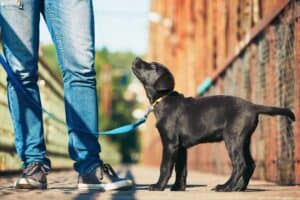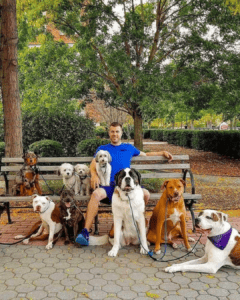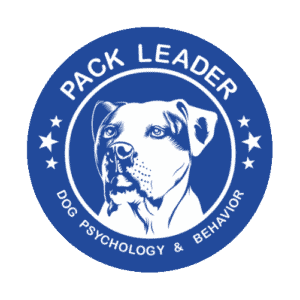1) Exercise.
Bringing a dog with pent up energy to meet another dog for the 1st time is a recipe for disaster. High energy and excitement can lead to the other dog seeing your dog as disrespectful or unbalanced. Be sure to provide sufficient structured exercise for your dog so your dog’s gas tank isn’t full when meeting. Long walks, a jog, rollerblading, bike rides, adding a back pack to your dog and swimming are all great ways to drain that energy before a meeting. Asking your friend or family member to do the same with their dog will only make things easier.
2) Knowing the Other Dog’s Energy.
If you haven’t met the other dog, it may be a good idea to see the other dog to understand what type of energy you will be bringing your dog around. I understand that sometimes this isn’t possible, but if at all possible, I’d recommend it. Ask the owner how the dog does with other dogs. Watch how the dog and owner interact. Is the human practicing leadership and do they have the dog under control? Is the dog balanced? If not, it may not be the right dog for your dog to be around.
3) Stay Calm and Confident.
This is a given. No matter what we do with dogs, it’s always important to stay in a calm and confident state of mind. If we are projecting nervous or anxious energy when introducing our dog to a new dog, your dog will feel that unstable energy and may interpret that the new dog is causing you to feel that way. This can cause your dog to become protective which may cause a bad outcome. By staying calm, we are projecting a balanced energy that will never have a negative effect on the dog or situation. By staying confident, we are letting our dog know that we have control of the situation which will make them feel safe and comfortable about the new dog they are meeting.
4) Go for a Walk.
Allowing dogs to meet face to face can be very confrontational and can send the wrong message about the meeting. Instead, ask your family member or friend to bring out their dog and go for a long walk with you and your dog. This will bring out what we like to call pack drive where the dogs feel like they are migrating together as a pack with humans in charge. Keep the dogs on the outside to start and focus on proper leash walking. Use your instincts to assess the energy of both dogs. When both dogs are calm and in a follower state, you can move each dog to the inside, one at a time. When this happens, excitement can escalate so be sure to address the excitement by correcting and reminding the dogs to stay calm. If everything is going great, you can stop and allow the dogs to calmly smell each other’s rears. Be sure to guide your dogs head to the rear of the other dog and ask your friend or family member to do the same with their dog. Stay calm and allow them to meet on a loose leash. If you notice any tension or confrontation, calmly remove your dog from the meeting.
5) Take Your Time.
There is no time limit on introducing new dogs. Some dogs will be compatible right from the get go and others may take longer to warm up to each other. Some dogs may not even be interested in the other dog but learn to tolerate their presence. When you go for the walk, you may never even move your dogs to the inside on the 1st walk. There’s nothing wrong with that! Try again another time and wait until you both feel comfortable taking the next step. As always, patience is key.
6) Use Tools.
Tools will never replace projecting calm and confident energy, however, tools can help you achieve that state of mind. For instance, I suggest using a muzzle or muzzles if necessary. So many people think a muzzle is just to prevent a bite. While it does do just that, the muzzle can be more for the human than the dog in my opinion. What I mean by that is when a dog is wearing a muzzle, the fear of a damaging bite is no longer there. Knowing that the worst that could possibly happen is a lunge with no damage, humans will likely feel calmer about the introduction. That calm energy will make for a greater possibility of a good meeting as we discussed earlier. Leashes are also a fantastic tool as well but remember, the greatest tool you have is your energy!
7) Rules, Boundaries and Limitations.
After a successful walk, be sure not to just let the dogs do whatever they want. If you decide to take the next step and enter the home with the dogs, keeping leashes on for the time being is always a good idea. Something we’ve found to be very successful is putting both dogs on separate beds or places in the same room but at a distance and keeping them there. The place command is something that can be practiced in advance of a meeting. Over time you can allow one dog at a time off their bed or place while the other continues to stay on their place or bed. Remember to advocate for the dog that is remaining on their place. If the one dog rushes the other dog with excitement, it’s important for you to step in as leader and correct the excitable dog. As you complete successful repetitions of one dog at a time having freedom, you can allow both dogs to have more freedom while being supervised. Having the dogs drag leashes can also be a good idea as it will give you more access to the dog in the event you need to correct. Keeping calm and following the laws of dog psychology is a must as always.
8) Hire a Professional.
It’s never a bad idea to hire a professional with experience in this area to help with introducing new dogs. Be honest with how you are feeling about introducing your dog to a new dog. If you think you can just put on a game face and fool the dog into thinking you are calm, think again. Remember, dogs have X–ray vision when it comes to reading energy and will pick up on how you really feel. Having a professional to guide you through the process, especially the first time, can set you up for long term success. A professional may even recommend socializing your dog with some of their more balanced dogs to begin with so your dog can understand what is and isn’t acceptable in a social setting with multiple dogs. They can also teach your dog how to interpret cues from other dogs and how to respond to those cues. Do your research and find a trainer or behaviorist who has experience in this area and has great testimonials to back it up.

![Steve-with-dogs[1] Steve Del Savio sitting on park bench with pack of dogs](https://packleaderdogs.com/wp-content/uploads/elementor/thumbs/Steve-with-dogs1-qfbe02j70tahmq2pimioxjb415pfh8l5rs9z6rpkso.png)


